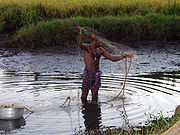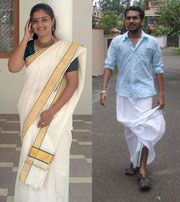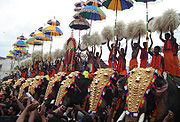The 31.8 million Keralites are predominantly of Malayali ethnicity, while the rest is mostly made up of Jewish and Arab elements in both culture and ancestry. Kerala's 321,000 indigenous tribal Adivasis, 1.10% of the population, are concentrated in the east. Malayalam is Kerala's official language; Tamil and various Adivasi languages are also spoken by ethnic minorities. Kerala is home to 3.44% of India's people; at 819 persons per km2, its land is nearly three times as densely settled as the rest of India, which is at a population density of 325 persons per km2. Kerala's rate of population growth is India's lowest, and Kerala's decadal growth (9.42% in 2001) is less than half the all-India average of 21.34%. Whereas Kerala's population more than doubled between 1951 and 1991 by adding 15.6 million people to reach 29.1 million residents in 1991, the population stood at less than 32 million by 2001. Kerala's coastal regions are the most densely settled, leaving the eastern hills and mountains comparatively sparsely populated.
Women compose 51.42% of the population. Kerala's principal religions are Hinduism (56.2%%),  Islam (24.70%), and Christianity (19.00%). Remnants of a once substantial Cochin Jewish population also practice Judaism. In comparison with the rest of India, Kerala experiences relatively little sectarianism. Kerala's society is less patriarchal than the rest of the Third World. Kerala government states gender relations are among the most equitable in India and the Third World[Need quotation on talk to verify, despite discrepancies among low caste men and women. Certain Hindu communities such as the Nairs, some Ezhavas and the Muslims around Kannur used to follow a traditional matrilineal system known as marumakkathayam, although this practice ended in the years after Indian independence. Other Muslims, Christians, and some Hindu castes such as the Namboothiris and the Ezhavas follow makkathayam, a patrilineal system. Owing to the former matrilineal system, women in Kerala enjoy a high social status. Islam (24.70%), and Christianity (19.00%). Remnants of a once substantial Cochin Jewish population also practice Judaism. In comparison with the rest of India, Kerala experiences relatively little sectarianism. Kerala's society is less patriarchal than the rest of the Third World. Kerala government states gender relations are among the most equitable in India and the Third World[Need quotation on talk to verify, despite discrepancies among low caste men and women. Certain Hindu communities such as the Nairs, some Ezhavas and the Muslims around Kannur used to follow a traditional matrilineal system known as marumakkathayam, although this practice ended in the years after Indian independence. Other Muslims, Christians, and some Hindu castes such as the Namboothiris and the Ezhavas follow makkathayam, a patrilineal system. Owing to the former matrilineal system, women in Kerala enjoy a high social status.
 Kerala's human development indices - primary level education, health care and elimination of poverty - are among the best in India. According to a 2005-2006 national survey, Kerala has one of the highest literacy rates (89.9%) among Indian states and life expectancy (73 years) was among the highest in India in 2001. Kerala's rural poverty rate fell from 69% (1970-1971) to 19% (1993-1994); the overall (urban and rural) rate fell 36% between the 1970s and 1980s. By 1999-2000, the rural and urban poverty rates dropped to 10.0% and 9.6% respectively. These changes stem largely from efforts begun in the late 19th century by the kingdoms of Cochin and Travancore to boost social welfare. This focus was maintained by Kerala's post-independence government. Kerala's human development indices - primary level education, health care and elimination of poverty - are among the best in India. According to a 2005-2006 national survey, Kerala has one of the highest literacy rates (89.9%) among Indian states and life expectancy (73 years) was among the highest in India in 2001. Kerala's rural poverty rate fell from 69% (1970-1971) to 19% (1993-1994); the overall (urban and rural) rate fell 36% between the 1970s and 1980s. By 1999-2000, the rural and urban poverty rates dropped to 10.0% and 9.6% respectively. These changes stem largely from efforts begun in the late 19th century by the kingdoms of Cochin and Travancore to boost social welfare. This focus was maintained by Kerala's post-independence government.
|
 Islam (24.70%), and Christianity (19.00%). Remnants of a once substantial Cochin Jewish population also practice Judaism. In comparison with the rest of India, Kerala experiences relatively little sectarianism. Kerala's society is less patriarchal than the rest of the Third World. Kerala government states gender relations are among the most equitable in India and the Third World[Need quotation on talk to verify, despite discrepancies among low caste men and women. Certain Hindu communities such as the Nairs, some Ezhavas and the Muslims around Kannur used to follow a traditional matrilineal system known as marumakkathayam, although this practice ended in the years after Indian independence. Other Muslims, Christians, and some Hindu castes such as the Namboothiris and the Ezhavas follow makkathayam, a patrilineal system. Owing to the former matrilineal system, women in Kerala enjoy a high social status.
Islam (24.70%), and Christianity (19.00%). Remnants of a once substantial Cochin Jewish population also practice Judaism. In comparison with the rest of India, Kerala experiences relatively little sectarianism. Kerala's society is less patriarchal than the rest of the Third World. Kerala government states gender relations are among the most equitable in India and the Third World[Need quotation on talk to verify, despite discrepancies among low caste men and women. Certain Hindu communities such as the Nairs, some Ezhavas and the Muslims around Kannur used to follow a traditional matrilineal system known as marumakkathayam, although this practice ended in the years after Indian independence. Other Muslims, Christians, and some Hindu castes such as the Namboothiris and the Ezhavas follow makkathayam, a patrilineal system. Owing to the former matrilineal system, women in Kerala enjoy a high social status. Kerala's human development indices - primary level education, health care and elimination of poverty - are among the best in India. According to a 2005-2006 national survey, Kerala has one of the highest literacy rates (89.9%) among Indian states and life expectancy (73 years) was among the highest in India in 2001. Kerala's rural poverty rate fell from 69% (1970-1971) to 19% (1993-1994); the overall (urban and rural) rate fell 36% between the 1970s and 1980s. By 1999-2000, the rural and urban poverty rates dropped to 10.0% and 9.6% respectively. These changes stem largely from efforts begun in the late 19th century by the kingdoms of Cochin and Travancore to boost social welfare. This focus was maintained by Kerala's post-independence government.
Kerala's human development indices - primary level education, health care and elimination of poverty - are among the best in India. According to a 2005-2006 national survey, Kerala has one of the highest literacy rates (89.9%) among Indian states and life expectancy (73 years) was among the highest in India in 2001. Kerala's rural poverty rate fell from 69% (1970-1971) to 19% (1993-1994); the overall (urban and rural) rate fell 36% between the 1970s and 1980s. By 1999-2000, the rural and urban poverty rates dropped to 10.0% and 9.6% respectively. These changes stem largely from efforts begun in the late 19th century by the kingdoms of Cochin and Travancore to boost social welfare. This focus was maintained by Kerala's post-independence government.

